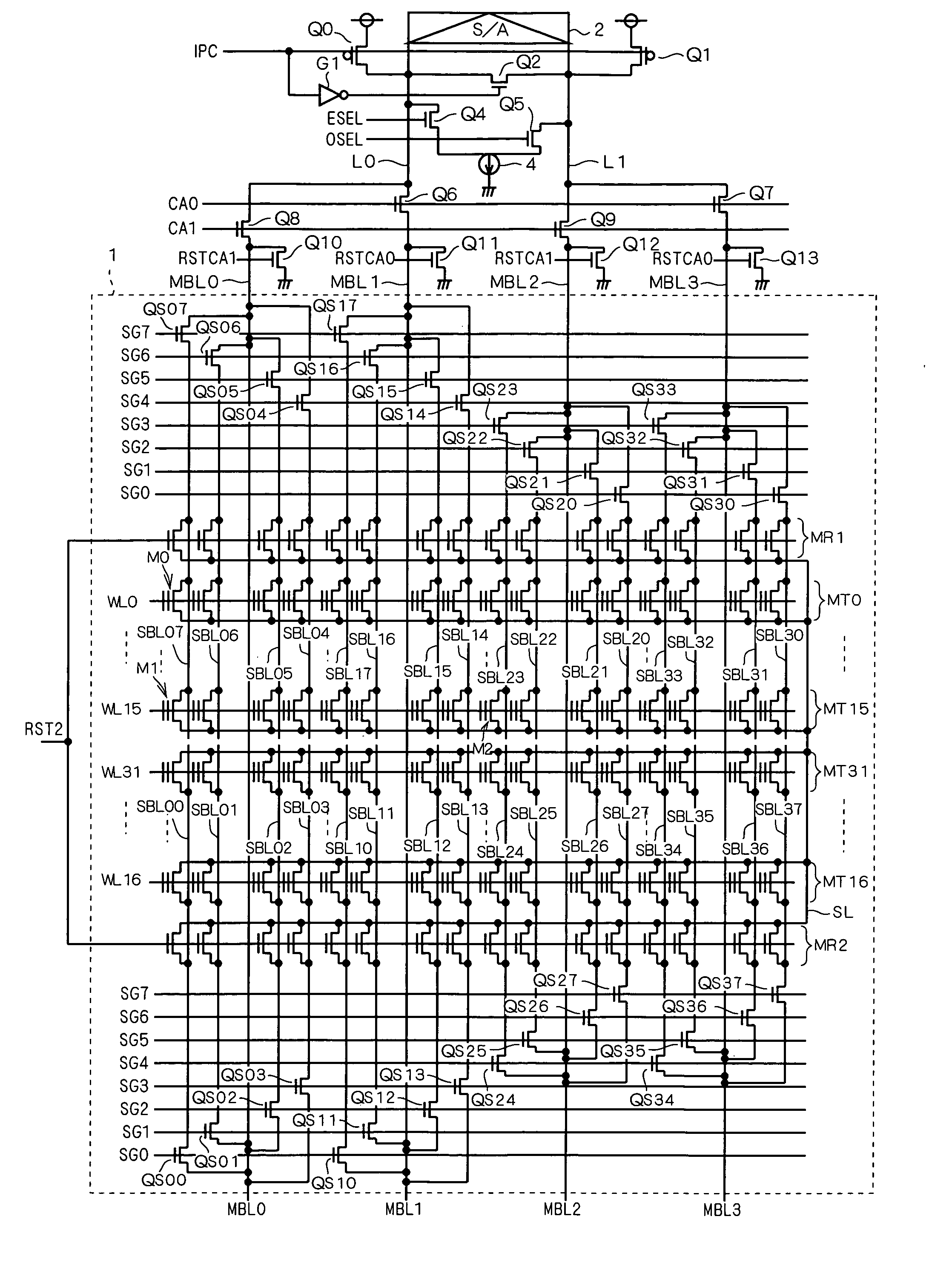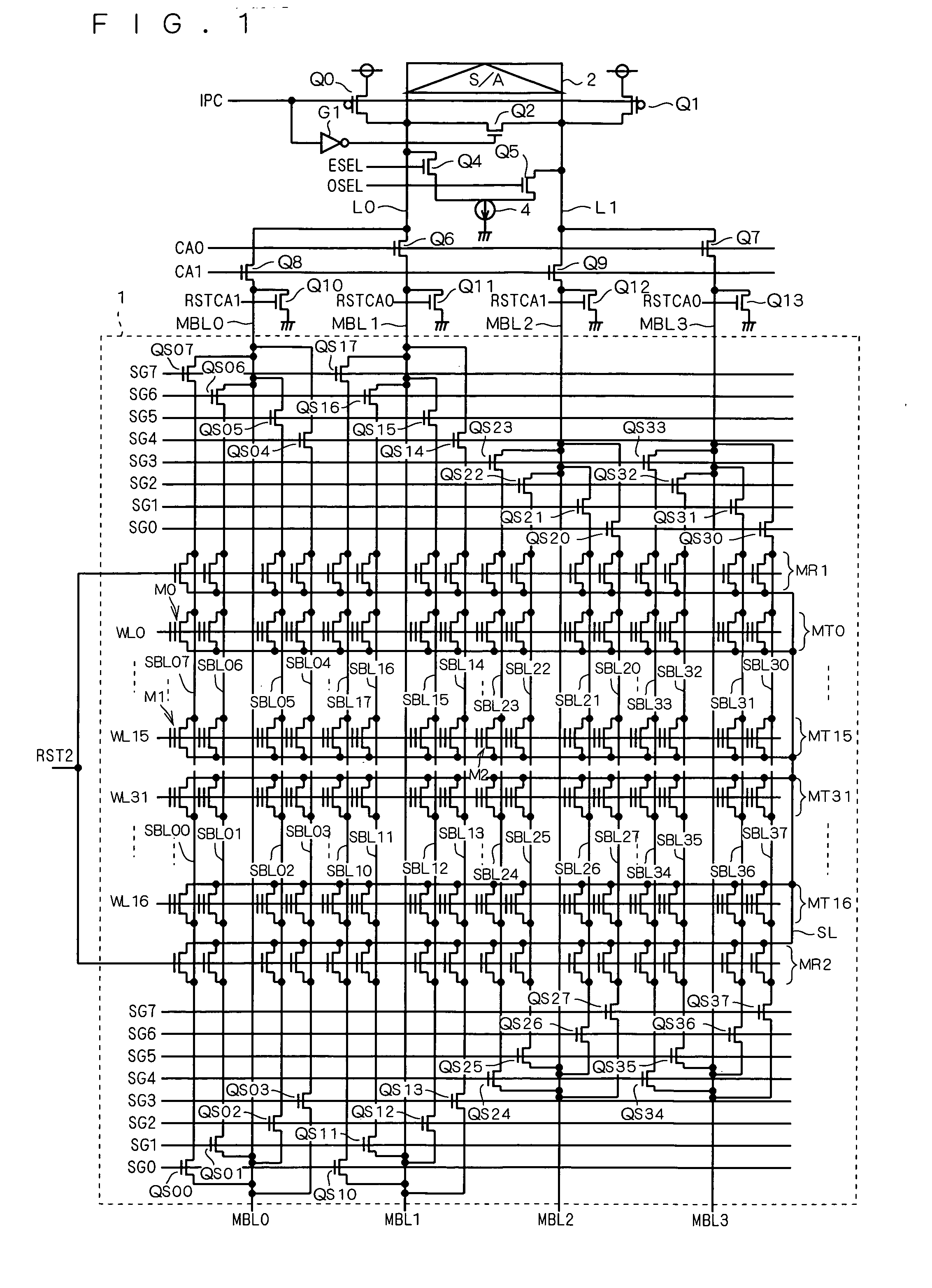Nonvolatile semiconductor memory device that achieves speedup in read operation
- Summary
- Abstract
- Description
- Claims
- Application Information
AI Technical Summary
Benefits of technology
Problems solved by technology
Method used
Image
Examples
first preferred embodiment
[0026]FIG. 1 is a circuit diagram illustrating part of a read circuit configuration in a flash memory according to a first preferred embodiment of the present invention. As shown, an erase block 1 is provided correspondingly to one sense amplifier 2. In actuality, a plurality of erase blocks provided correspondingly to a plurality of sense amplifiers constitute a group of erase blocks erasable at a time. For example, to 64 sense amplifiers, 64 erase blocks 1 shown in FIG. 1 may constitute a group of erase blocks of one unit, or 32 sense amplifiers each may constitute a group of erase blocks of two units. Alternatively, a predetermined number of erase blocks 1 shown in FIG. 1 may be further provided in the direction of main bit line.
[0027] The sense amplifier 2 is a differential circuit supporting high-speed reading that obtains read data by detecting and amplifying a difference between the amounts of current flowing through sense lines L0 and L1, respectively. Precharge transistors...
second preferred embodiment
[0067]FIG. 6 is a circuit diagram illustrating part of a read circuit configuration in a flash memory according to a second preferred embodiment of the present invention. As shown, inversion buffers 5 and 7 having their respective inputs receiving the sub-bit line reset signal RST2 are provided, and inversion buffers 5 and 6 connected in series output an upper sub-bit line reset signal URSTSBL to the gates of the sub-bit line reset transistors MR1, while inversion buffers 7 and 8 connected in series output a lower sub-bit line reset signal LRSTSBL to the gates of the sub-bit line reset transistors MR2.
[0068] In the second preferred embodiment, the sub-bit lines SBL04 to SBL07, SBL14 to SBL17, SBL20 to SBL23, SBL30 to SBL33, and the memory transistors MT0 to MT15, the word lines WL0 to WL15 and the like connected by the upper sub-bit line reset signal URSTSBL form an erase block 11, and the sub-bit lines SBL00 to SBL03, SBL10 to SBL13, SBL24 to SBL27, SBL34 to SBL37, and the memory ...
third preferred embodiment
[0080] A read circuit configuration in a flash memory according to a third preferred embodiment of the present invention is the same as shown in FIG. 6 of the second preferred embodiment. The difference is the fall timing indicated by the sub-bit line selection-timing signal SGT and the rise timing indicated by the main bit line reset-timing signal RSTMBL in the control section 10 shown in FIG. 2.
[0081]FIG. 8 is a timing diagram illustrating two sequential read operations of the read circuit in the flash memory according to the third preferred embodiment. As shown, first and second read operations are sequentially performed during the read periods TR1 and TR2, in the same way as the first and second preferred embodiments.
[0082] Only the different respects from the second preferred embodiment will be explained below. The sub-bit line selection signal SG7 falls at time t11 which is delayed by a period TE from time t10 when the word line WL0, the main bit line selection signal CA1, a...
PUM
 Login to View More
Login to View More Abstract
Description
Claims
Application Information
 Login to View More
Login to View More - R&D
- Intellectual Property
- Life Sciences
- Materials
- Tech Scout
- Unparalleled Data Quality
- Higher Quality Content
- 60% Fewer Hallucinations
Browse by: Latest US Patents, China's latest patents, Technical Efficacy Thesaurus, Application Domain, Technology Topic, Popular Technical Reports.
© 2025 PatSnap. All rights reserved.Legal|Privacy policy|Modern Slavery Act Transparency Statement|Sitemap|About US| Contact US: help@patsnap.com



